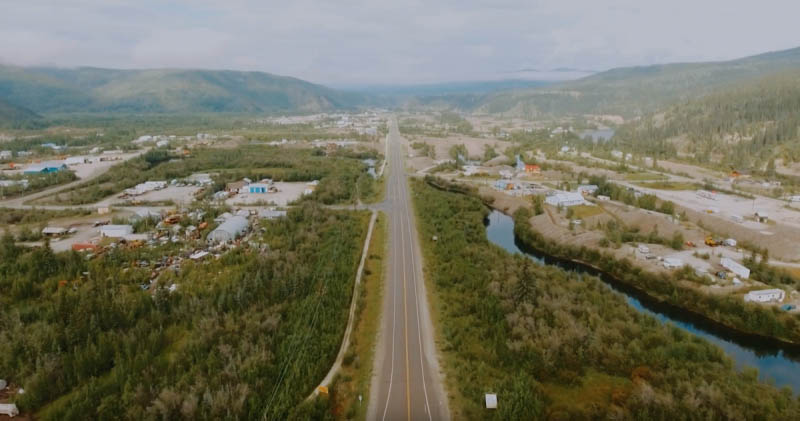Radio show with Jay Taylor and his guest Peter Tallman
Listen to this insightful conversation with Jay Taylor, editor of J Taylor’s Gold & Technology Stocks newsletter and Klondike Gold President and CEO Peter Tallman to get an update on the new geological insights gained from this past year’s drill program.
Jay Taylor:
Welcome back to Turning Hard Times Into Good Times. I am your host, Jay Taylor, and I’m really glad to have Peter Tallman with me once again. He is the President and CEO and he’s the Director of Klondike Gold Corp. It’s one of my favourite stocks. Personally, one of my larger holdings. And I’m really pleased to have him with us again. He is a very experienced geologist. An exploration geologist. He has worked more than 35 years in the industry. Canada, Chile, Mexico, Australia, and he’s now working with Klondike Gold Corp, which is, I think, onto a very fascinating, potentially very large scale, gold discovery.
Jay Taylor:
Peter, thanks for joining me again.
Peter Tallman:
Jay, it’s a pleasure to be back.
Jay Taylor:
It really is good to have you and especially now that the drill data is coming in from last year’s drill program. We’re gonna be waiting for a lot of that data to come in yet, but I guess I should tell our listeners that Klondike Gold Corp trades in Canada under KG, can buy it in the U.S., as I have, under the symbol KDKGF. 96.8 million shares, Peter, that’s about what I see recently. Now, you’re selling though at a mere $0.14 in the U.S., which gives you a market cap of, I calculated like, $13.8 million in U.S. money, a little more than that in Canadian money. But your stock has gotten battered, which you never like to see, but boy, I’m telling you, if you understand what you have there, and I try to. I work hard at it and that’s why we have you here because we’d like to know: Is this just a cheap stock or is this stock with great opportunity?
Jay Taylor:
Well Peter you were just at a professional conference, I think, mostly geologists that you were speaking to from major mining companies, some of them at least. Up in the Yukon, that’s where you’re doing your work, where your company is exploring. Despite the massive Gold Rush of the late 1800s, there’s not been much serious exploration until you got involved recently, last few years, regarding the source of that placer gold that was, you know, is one of the most spectacular placer discoveries in the late 1800s. You started to view this from a geological perspective quite differently than had been looked at before. Perhaps you can, in lay terms, tell our listeners how you view this geology differently from what previous exploration, because there were some people poking around up there … I know one geologist concluded that, “Well it must’ve all been eroded away over millions of years.” And what you’re saying is, “Not so fast. You’re finding a lot of gold there.” But tell us, how do you view this differently from a geological perspective than your predecessors?
Peter Tallman:
It’s Klondike Gold year four for exploration now. And really years one to three were spent expressly disproving the idea that all the gold has eroded away and there’s none left in the bedrock. And we have done that and as years one to three went on, we found more and more and more gold and found concentrations of it that were– could develop into something potentially. In year four, it’s what I just got back from this geology conference to report, but we spent the year mostly doing stealth science so our investors generally are somewhat cranky when you tell them that you have to do all this basic geoscience to try to figure out stuff. They’d much prefer to have drilling going on all the time, which we did, but we had a really big geoscience program that spanned all gamuts of what you can do with geology to look at it and came up with a completely different scientific explanation now for why the gold is there, when it is there, and what hosts it.
Peter Tallman:
So, the importance of it is, first, we can … Last year, at the end, when I was talking to you, I was saying, how “look, we have these faults and we know there’s gold in them and every time we go along that fault in that area we find gold.” But there really wasn’t an understanding, although we were getting there. We’ve now spent the full year, and the entire team has contributed as well as all of our consultants, and we have a specific explanation of how that gold occurs and in what rock types. And, strangely enough, when I went to the conference, I was gonna present this idea as a brand new “hey look, this actually re-writes some of the geology of the Yukon.” I was speaking third on this particular day and the first talk up in the morning was the geologist talking about the Coffee deposit that Goldcorp now owns and they’re our neighbor.
And she pre-empted what I was gonna say, basically, and said, “Oh look, we have a new view of the geology and the timing, and it’s this, not what other people previously thought.” And the second talk up was on White Gold, so that’s Golden Saddle and a bunch of new discoveries. Again, another neighbor Klondike, right beside us. And they presented the same structural data and system and said, “look we’re finding all our gold on these structures and this is why it’s there.” They disagreed somewhat on the timing [inaudible 00:05:35], but then I get up and presented and said, “hey look, guess what? All the structures are the same as the Coffee deposit, as the Golden Saddle deposit, and all these things are exactly the same.”
Peter Tallman:
And I think that, well I know, physically what happened as soon as I get off the stage and walked out. Again, the audience was geologists and mostly all the majors, world gold mining majors and all of their senior geos, to listen to these talks and I was approached by three of them, consecutively, right afterwards and said, “we want you to pitch to us now.” So…
Jay Taylor:
Yeah. Wow. Good.
Peter Tallman:
It’s a scientific validation more so than an investor validation.
But it’s really important and I think they instantly got the idea that there’s potential there.
Jay Taylor:
Well I know that … you increasingly saw your project as a look-alike with the Coffee deposit that was picked up by Goldcorp for a pretty penny a few years ago. So you have a lot of attention from the majors, which I guess you are happy about, right? It’s better to have those guys interested in you because you’re not gonna mine this thing, it’s really large, you’re an exploration geologist, and some of those companies are looking for large, I mean all the big guys are looking for large deposits because they’re running out of gold. They can’t find it as fast as they produce it. At least that’s the case with most companies. Go ahead.
Peter Tallman:
Because my talk followed Coffee, I wasn’t aware of all the nitty gritty details, but what was presented in the Coffee talk, I’ve followed up and said even the nitty gritty details of what we have occur also at Coffee.
Jay Taylor:
Wow.
Peter Tallman:
And so to see this is not only just kinda, sorta like that, it’s exactly like that.
Jay Taylor:
Interesting.
Peter Tallman:
And the Goldcorp guys, of course, that’s one of the major access routes. They drive through our property to get to Coffee. Yeah, there’d be some synergies there, some obvious synergies. And so, yes, I suspect Goldcorp will be one of the groups that are interested.
Jay Taylor:
Maybe we should just review, once again, what you’re doing there. You have a lot of drill data coming back yet because I guess the labs are jammed full this year. You mentioned there’s going to be a tidal wave of data coming out. How soon do you expect to have received all of the drill results from this year and how extensive was your drill program? And what did you learn from it, essentially?
Peter Tallman:
Well, it’s the biggest drill program we’ve had yet. 87 holes in total. I think we’ve reported 50, so there’s 40 some odd, 45, 47 holes left to come. But I kinda prodded the lab while I was there at the conference and they have now started to deliver the outstanding assays. I was forecasting we’d be still be reporting drill results in January. That may be true, but I might get most of ’em out before that.
Jay Taylor:
Before that.
Peter Tallman:
What have we learned? We’ve learned that our principle target, the Lone Star zone, is big. We’ve drilled 900 meters of strike length down to, or back across, 200 meters. Pretty much every hole we’ve drilled in it has hit and, I believe, there are extensions to it, so we have drilled a 1.6km-long, well spacing, all-in. We’ve also tried to drill our second best target. We don’t have much information from it, it’s called Nugget and and we drilled 25 holes there. Still waiting for any assays from 2018. That’d be nice to see. But if we get something out of that, I’ll be really optimistic that Nugget develops into a target that looks as good as Lone Star, if not better.
Peter Tallman:
And then we drilled a couple of wing nut holes right at the end, as they usually do. Like four or five holes off on the middle, everywhere. Who knows? Let’s go learn something. And, again, those aren’t particularly critical. They’re kinda like the Gold Run holes from last year or the beginning of this year. Let’s just go learn and try to get a better handle on the geology and where the gold is.
I’m really optimistic that we have, well we do have, a reasonably significant amount of gold contained at Lone Star and we’re hoping to develop something at Nugget. And now that we have a really strong exploration model, we have targets up and down the belt that look really good.
Jay Taylor:
Well I suppose once you get all the data in, you’ll pull it together, you’ll look at it, and then you’ll start to think about what you’re going to do in 2019, right? Do you have any thoughts about that now? Will you just continue on the Lone Star and try to prove up some sort of large resource and, if so, how soon might that happen? Or you’ve got the Nugget zone, you’ve got other zones all over the place up there. This is a huge target, which is a disadvantage in the sense that it’s just a lot to look at. It takes a lot of time, but what are your thoughts? Do you think you’ll focused on the Lone Star to try to look at something economic there or will spread yourself out on some of these other areas?
Peter Tallman:
We have $2.5 million allocated for drilling already. We have that in treasury. So we’re going to go drilling for sure. That’s going to be somewhere between eight and 10 thousand meters, which will start at Lone Star and Nugget and the intention is, at least for the majority of that money, to outline … we’re aiming for two million ounces of gold contained, in a resource estimate, that would come through 2019 and 2020 drilling. So we have money to fund the 2019 program. We don’t have money yet for 2020. That said, there are some higher-grade opportunities. We’re going to go drill a couple of those as well in 2019 and see where we get to. But the objective is, more or less, focused on– what has obviously kinda bored the market is this delineation 50 meter centers, you keep getting, delivering the same result as they did the last news release.
Peter Tallman:
It somewhat bores everyone, but it’s significant because we’re adding ounces every time hit, so…
Jay Taylor:
Yeah. I mean you’re doing it. The big news here is it’s disseminated. It’s not just high-grade veins. It’s a lot of dissemination over fairly long widths and strike lengths. The drill intercepts that you’ve reported and, yes, they’re not spectacular, but they’re good, long intercepts with gold in them and I guess your idea is to prove up ounces first. Get to that two million ounce and then you’ll start to hone in on economics maybe somewhere down the road.
Peter Tallman:
Well we’re kinda doing that now, but actually one of the things that the big guys picked up on in my talk was that the gold, least on preliminary data, provisionally, it’s free gold.
Peter Tallman:
So it’s free gold, sitting at the surface. It doesn’t necessarily need, well it certainly doesn’t need, so far as we know it’s not heap leach. We can recover it with gravity methods so it’s cheap. If you get a substantial amount of it drilled off and, again, it’s sitting at surface, all of this starts at surface. It’s potentially economically, it has advantages over some of the other zones, put it that way.
Peter Tallman:
And so that’s what we’re trying to do, is find something that looks good and have enough of it that it definitely forms the basis of what could be either a significant regional play, because we believe there’s gold all through the district. We’ve identified new zones as well. The first thing now is to prove that there is something potentially economically viable of size.
And that’s what we’re–
Jay Taylor:
–yeah. Well I can tell you one thing as a shareholder. I hope that your shares pick up after this tax loss selling is over. I hope your shares pick up quite a bit before you do any deal with the major, that’s all I can say. I think that’s probably something that will happen in 2018 or are you going to try and hold ’em off until you get a better price or I guess it will depend on the markets too, right?
Peter Tallman:
I heard the words “strategic partnership” and so, to me, that doesn’t mean financing at $0.15 or $0.20.
Jay Taylor:
Right, right.
Peter Tallman:
And I’m not really that interested… as you know we have two major, we have billionaire mining investors, two of them. Actually more than that, but those are significant guys. They each own 14 or 13% of the company and they’re prepared to underwrite us–
Jay Taylor:
Yeah. They don’t have to sell your stock for the next meal, in other words.
Peter Tallman:
Exactly. They’re in for the home run and that’s what they want to see. First, discover the source of the Klondike, all that alluvial 20 million ounces of gold and find something significant. And so we’re on track for that. Everyone is happy with the exception of the share price, which–
Jay Taylor:
It’ll be okay.
Peter Tallman:
We’re pretty optimistic.
Jay Taylor:
Yeah. Good. Well we have to leave it go at that, Peter. We’re out of time. Thank you so much for updating us with your story. It is a good one and it’s one that I’ll be watching and, maybe at these prices, pick up some more shares. Thanks so much for being with us.





